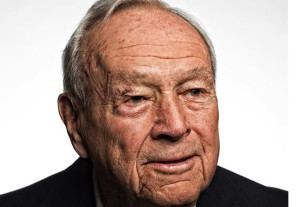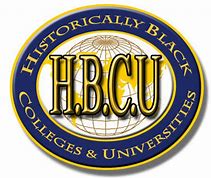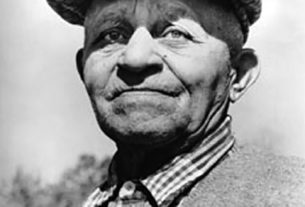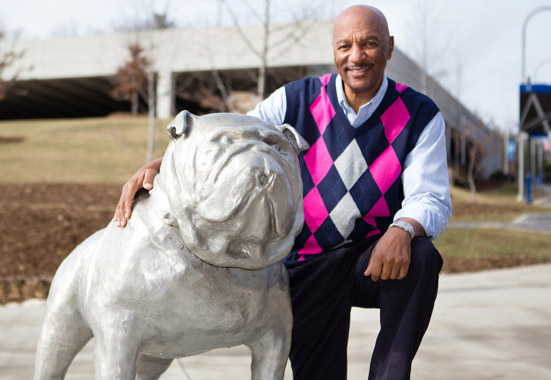 by Michael Bamberger (excerpt)
by Michael Bamberger (excerpt)
photo by Kaitlin Santanna Graphic
Arnold Palmer died Sunday September 25, 2016 in Pittsburgh, Pennsylvania, at age 87 The news was first reported by Golfweek.
Palmer led an American life that will never be duplicated, so rooted was it in a lost time and a place and the sui generis chemistry of the man.
The golf legend won his last major championship in 1964 and his last PGA Tour event in 1973, but in the 43 years since then his status as an international icon has only grown. He had a knack for making people feel better about themselves, and about their prospects. As a player, he allowed his fans to join him in his unbridled assertiveness. He created a vicarious thrill as no player before him and none since. When his golf skills faded and his hair turned silver and then white, he exuded grandfatherly warmth that was also unmatched, possibly in any sport. For these and other reasons he was not only the most beloved figure ever to play golf but the rare golfer who was able to transcend a niche sport and become a genuine celebrity.
At the 2016 Masters, Palmer did not hit a ceremonial opening tee shot alongside his friends Gary Player and Jack Nicklaus — that trio in its prime was marketed as the Big Three — and Nicklaus, his great rival, spoke about Palmer’s absence with notable sadness, already anticipating today’s news. Two months later, at the U.S. Open at Oakmont, 35 miles from Palmer’s hometown in Latrobe, Pa., players and commentators, young and old and in between, paid tribute to the man known as the King. All of golf has been preparing itself emotionally for Palmer’s death, which for millions of golfers around the world was almost like losing a parent. The golfer Chi Chi Rodriguez spent decades preaching this message: “Every touring pro should bow down and pray to Arnold Palmer, for what he did for golf.”
In the late 1950s and early 1960s, Palmer, by virtue of his spectacular wins and losses, made golf a sport that enjoyed broad popularity on TV. All he had to do was contend, and he often did. It has been said that Palmer sold a million color TVs — nobody wanted to watch him perform his magic in black-and-white, neither the man of the house, nor the lady.
Yes, the terms are old-fashioned: Palmer connected with conservative Middle America in ways that made him the envy of various presidents, Republican presidents in particular. Palmer had a particularly close relationship with Dwight Eisenhower.
He was an odd sort of matinee idol. Palmer had a rugged, regular-guy handsomeness — more out of the John Wayne school than anything else — but there was a physicality to him that drew men and women to him in almost equal numbers. He became, over the decades, fantastically rich, worth hundreds of millions of dollars. He was a child of the Depression and a proud son of the working-class and he lived, essentially, a modest life, except for his penchant for private planes. Palmer was an accomplished pilot who at one point had a world-record for circumnavigating the globe in a private plane. In his everyday lunchtime grillroom conversation, he spoke of his flying adventures with the same enthusiasm with which he spoke of golf, which is saying something.
The world has likely never seen anybody who loved golf more than Palmer did. He played or hit balls virtually every day of his life. His late first wife, Winnie Walzer Palmer, used to say that her husband would not last long if he could no longer fly his own plane or hit balls. Palmer gave up his pilot license, with great reluctance, in 2014 and was still hitting balls up until his final days.
Palmer didn’t have a quick wit, like Muhammad Ali, but he did have a directness that endeared him to millions of people regardless of their station in life. Almost like another icon of his era, Walter Cronkite, Palmer was consistent, reliable and trustworthy. Asked once how he made a 12 on a hole, Palmer said, “I missed the four-footer for 11.” His humor was often literal that way.
He was the first professional golfer with his own raucous cheering section. The original members of Arnie’s Army were GIs from Camp Gordon in Augusta, Ga., and Palmer was at ease with these enlisted men, knocking back cold ones with them on those occasions when they landed at the same bar. For some years in the 1950s and ‘60s, Palmer was a smoker, a vodka-and-steak man, and a night owl, but the protective press of his era never showed him in that light. People who followed the game closely knew, and he never pretended to be something other than what he was. He attended Wake Forest and was forever devoted to the university, but left in his senior year after his best friend, Bud Worsham, was killed in a car accident. Later, he served in the Coast Guard and at age 24 he was a half-lazy paint salesman with no particular direction. His life changed in August 1954, when he won the U.S. Amateur shortly before his 25th birthday. The next month, he met Winnie Walzer, a 19-year-old college student, at an amateur event in Pennsylvania on a Tuesday. That Saturday night he proposed. “Her father hated my ass,” Palmer once said. “He said, ‘You’re going to marry a golf pro?'” It was only in that period that Palmer decided to turn pro.
Businessmen had nothing on Palmer. He was, in 1995, a co-founder of Golf Channel and in that capacity made an indelible mark on the game while making, over time, millions of dollars. Over the years, the range of his business interests is mindboggling, with an ownership interest in dry cleaners, car dealerships, hotels, a golf-club manufacturing business, among many other ventures. He was a prudent investor but in general much preferred to be paid as a spokesman for various products, from Pennzoil starting in the early 1960s to a blood-clotting drug in recent years that had him appearing in TV spots with the comedian Kevin Nealon. There were scores of other products in between. Palmer’s stiffness as an actor added to his appeal and his credibility.
Palmer wrote more golf books (13) than Dan Jenkins, designed or remodeled more courses (350) than Pete Dye and sponsored more products than Dale Earnhardt and Dale Jr. together. He drove that famous red tractor for Pennzoil for years, ran through airports with O.J. Simpson for Hertz and appeared in an Electronic Arts video golf game with Tiger Woods. A hundred other deals could be added to that list.
He is on the Mount Rushmore of American sportsmen and when he was named Sports Illustrated Sportsman of the Year in 1960, Roger Maris and Cassius Clay and Frank Gifford all started talking about a golfer — a golfer! — as not only an athlete, but one that could be discussed in the same breath as a baseball slugger, a gold-medal winning boxer and a matinee-idol football player. In 1960, Palmer won the Masters and the U.S. Open and American golf had its first working-class hero. Palmer has signed that timeless SOTY cover thousands of times, his penmanship relentlessly consistent and legible. There cannot be anybody anywhere who has signed more autographs than Arnold Palmer.
Unlike almost every other great champion, the game still brought Palmer joy even after age started eroding his skills. He liked being in public, he liked being with the boys and he liked the challenge of trying to improve. He liked golf on every stage. One day, when he was in his 70s, Palmer was playing a par-3 course in the California desert. Early on, he found himself one down to a duffer but then started turning the match around. He shook his club and yelled joyfully, “I got you now!” Palmer was externally a conformist but internally a maverick and people found that combination irresistible. He could be a Harvard Business School case study for the athlete as celebrity endorser and businessman. He paved the way for Jean-Claude Killy, Jackie Stewart, Michael Jordan, Phil Mickelson, Tiger Woods and many others.
Palmer was not close to Woods but was deeply impressed by his talent and played with him a handful of times. He occasionally watched Woods working on the driving range with his father, Earl, at Isleworth, a massive Orlando real-estate development developed by Palmer and associates, with a Palmer-designed course. Palmer once said that Tiger’s relationship with Earl reminded him of his relationship with his father. Both fathers taught the importance of discipline and practice. Both instilled in their sons a competitive hunger bordering on starvation.
Palmer’s longtime agent, Alastair Johnston, recruited Woods to IMG. Palmer himself had a long association with Mark McCormack, the founder of IMG and the man who invented the Big Three (Palmer, Nicklaus and Player). Nicklaus, the Golden Bear, was a country-club kid and a plodder. Player, the Black Knight, was a globetrotting overachiever with movie-star looks. Palmer was simply The King. In the ’60s, he made cigarette-smoking look cool but, on the positive side of the ledger, gave the men’s line at Sears a stamp of legitimacy. Later, he became a public face of the anti-smoking campaign. Palmer, a prostate cancer survivor in his late 70s, also made earnest public service announcements about the importance of regular prostate exams.
Arnold Daniel Palmer — Arnie to millions — was born in Sept. 19, 1929, and he was a man of his generation in all the expected ways. He insisted on men removing hats upon entering the various clubhouses under his watch and was a big believer in the benefits of the firm handshake. He often said that the secret to his success as a golfer was the firm golf grip his father taught him as a young child, just a few years after the Great Crash. He never changed his grip, he never changed his swing, he never changed his personality.
The sports columnist Dave Anderson once wrote that nobody could enjoy being who he or she is more than Arnold Palmer enjoys being Arnold Palmer. That observation got to the heart of the man and the matter. Palmer lived a full life and got millions of other people to believe they could do the same.



